introduction - Catawba County Schools
advertisement
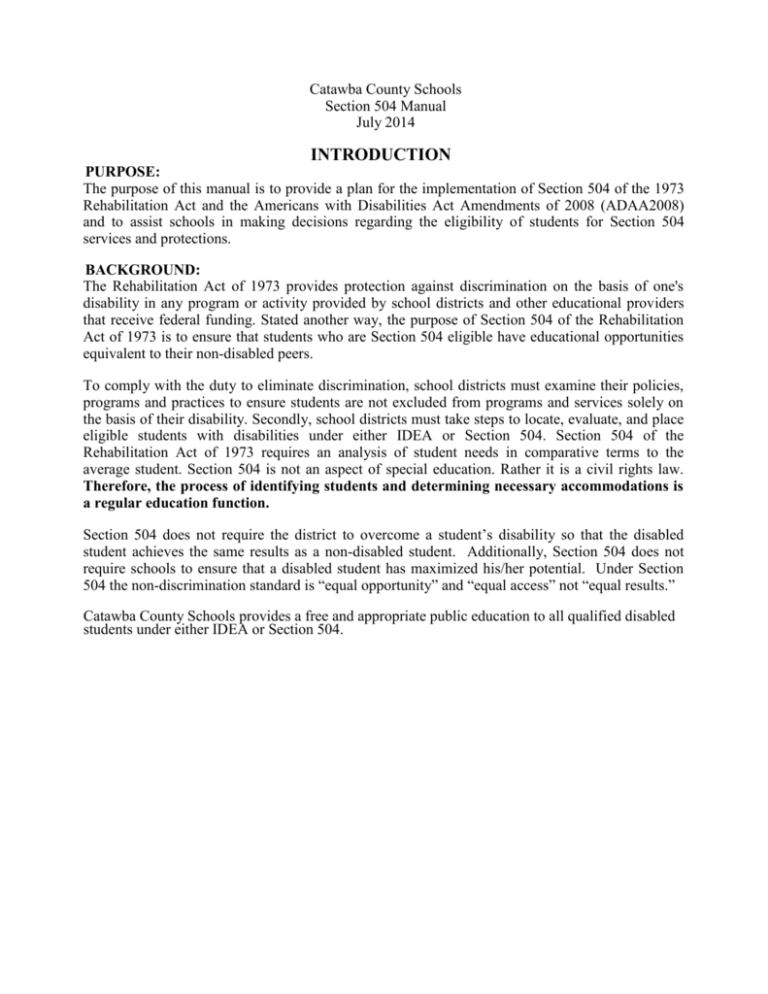
Catawba County Schools Section 504 Manual July 2014 INTRODUCTION PURPOSE: The purpose of this manual is to provide a plan for the implementation of Section 504 of the 1973 Rehabilitation Act and the Americans with Disabilities Act Amendments of 2008 (ADAA2008) and to assist schools in making decisions regarding the eligibility of students for Section 504 services and protections. BACKGROUND: The Rehabilitation Act of 1973 provides protection against discrimination on the basis of one's disability in any program or activity provided by school districts and other educational providers that receive federal funding. Stated another way, the purpose of Section 504 of the Rehabilitation Act of 1973 is to ensure that students who are Section 504 eligible have educational opportunities equivalent to their non-disabled peers. To comply with the duty to eliminate discrimination, school districts must examine their policies, programs and practices to ensure students are not excluded from programs and services solely on the basis of their disability. Secondly, school districts must take steps to locate, evaluate, and place eligible students with disabilities under either IDEA or Section 504. Section 504 of the Rehabilitation Act of 1973 requires an analysis of student needs in comparative terms to the average student. Section 504 is not an aspect of special education. Rather it is a civil rights law. Therefore, the process of identifying students and determining necessary accommodations is a regular education function. Section 504 does not require the district to overcome a student’s disability so that the disabled student achieves the same results as a non-disabled student. Additionally, Section 504 does not require schools to ensure that a disabled student has maximized his/her potential. Under Section 504 the non-discrimination standard is “equal opportunity” and “equal access” not “equal results.” Catawba County Schools provides a free and appropriate public education to all qualified disabled students under either IDEA or Section 504. UNDERSTANDING SECTION 504 OF THE REHABILITATION ACT OF 1973 AND THE AMERICANS WITH DISABILITIES ACT AMENDMENTS OF 2008. THE LAW: Section 504 of the Rehabilitation Act of 1973 requires that: No otherwise qualified individual with a disability in the United States shall, solely by reason of his or her disability, be excluded from participation in, be denied the benefits of, or be subject to discrimination under any program or activity receiving federal financial assistance. (29 USC 794) The Office of Civil Rights states that, “to be protected under Section 504, a student must be determined to: (1) have a physical or mental impairment that substantially limits one or more major life activities; (2) have a record of such an impairment; or (3) be regarded as having such an impairment.” PHYSICAL OR MENTAL IMPAIRMENT: 1. Any physiological disorder or condition, cosmetic disfigurement, or anatomical loss affecting one or more of the following body systems: neurological; musculoskeletal; special sense organs; respiratory, including speech organs; cardiovascular; reproductive; digestive; genitourinary; hemic and lymphatic; skin and endocrine. 2. Any mental or psychological disorder, such as mental retardation, organic brain syndrome, emotional or mental illness, and specific learning disabilities. ** the above list is not exhaustive SUBSTANTIALLY LIMITS: While the Office of Civil Rights will not define the term, “substantially limits”, school personnel are faced with making the determine if the impairment significantly restricts the individual’s ability to perform a major life activity in a manner comparable to that of an average student of approximately the same age and grade. MAJOR LIFE ACTIVITIES: Major life activities as defined by the Office of Civil Rights include but are not limited to: walking, seeing, hearing, speaking, breathing, learning and working. In the Amendments Act of 2008, Congress provided additional examples that include: eating, sleeping, standing, lifting, bending, reading, concentrating, thinking and communicating. ** the above list is not exhaustive COMPLIANCE: The determination of whether a student has a physical or mental impairment that substantially limits a major life activity must be made on the basis of an individual inquiry. The determination must be made by a team of person knowledgeable about the student and must draw from a variety of sources to minimize error and maximize information. TECHNICALLY ELIGIBLE: A student must demonstrate a substantial limitation in a major life activity or major bodily function to be considered as a qualified disabled student under the definitions set forth by Section 504 legislation. A student can be found to be “technically eligible” in other words, meeting the criteria for identification under Section 504, but not in need of an Equal Education Opportunity/Accommodation Plan. If it is determined that accommodations are necessary in order for the student to have equal access to his/her education as his/her non-disabled classmates, a plan will be developed. Equal access does not mean “extra” or “advantageous.”
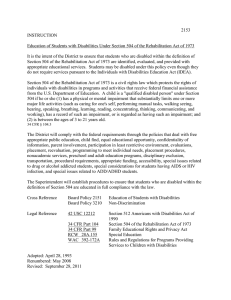
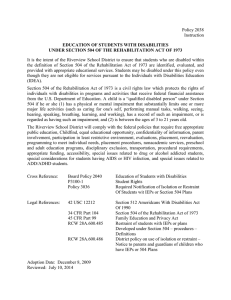
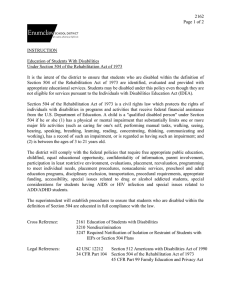
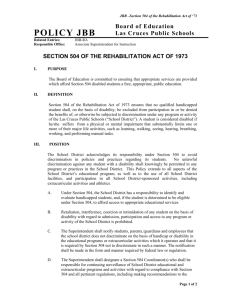
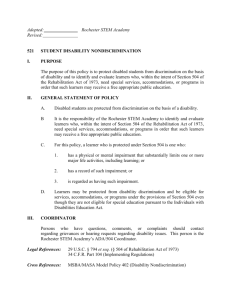
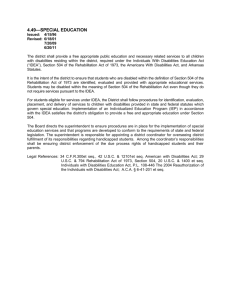
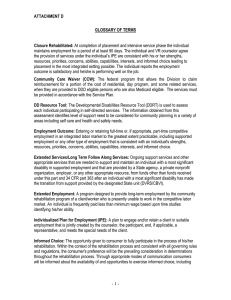
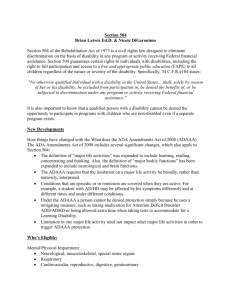
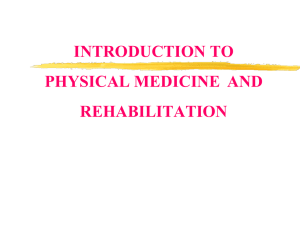
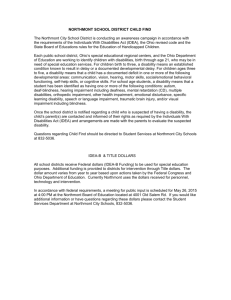
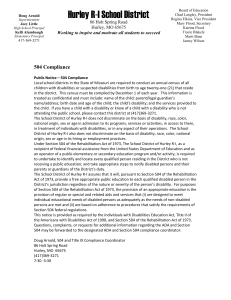

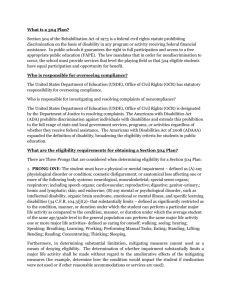
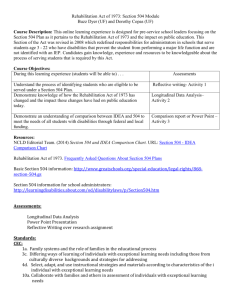
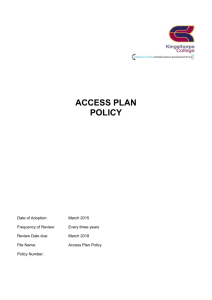
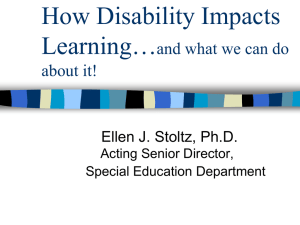
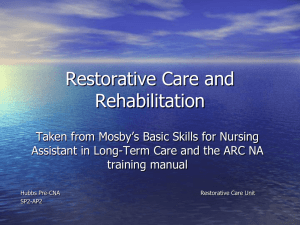
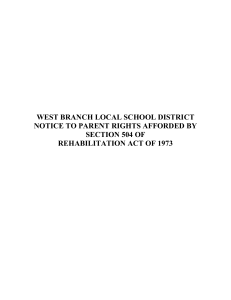
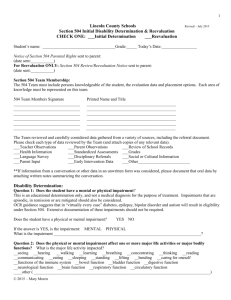
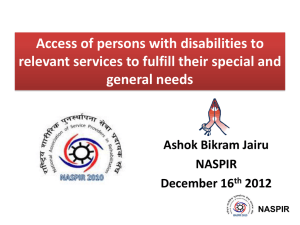
![You can the presentation here [Powerpoint, 1.01MB]](http://s2.studylib.net/store/data/005417570_1-0810139cfc2485ebcaf952e0ae8bb49a-300x300.png)
